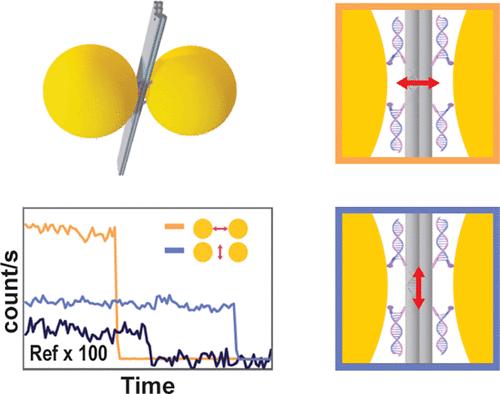将单分子耦合到具有位置和方向控制功能的 DNA 光天线上
IF 6.7
1区 物理与天体物理
Q1 MATERIALS SCIENCE, MULTIDISCIPLINARY
引用次数: 0
摘要
光学天线已被广泛用于操纵单光子发射器的光物理特性。发射器与光学天线特定谐振模式之间的耦合主要取决于三个参数:光谱重叠、相对距离以及发射器过渡偶极矩与天线之间的相对方向。虽然前两个参数已得到广泛证实,但由于同时操纵单个分子的位置和方向存在挑战,实现完全耦合控制仍有待探索。在这里,我们利用 DNA 折纸技术组装了一个二聚光学天线,并将单个荧光分子定位在天线间隙处,同时控制其方向,主要是平行或垂直于天线的主轴。我们通过与扫描电子显微镜图像相关的荧光测量来研究这两种条件下的耦合,结果表明,当发射器与天线主轴对齐时,平均荧光强度高出 5 倍,最大荧光增强可达 1400 倍。与现实数值模拟的比较表明,观察到的荧光增强分布是由发射器方向和间隙大小的微小变化引起的。这项工作确立了 DNA 折纸作为全面控制发射器和光学天线之间耦合的多功能平台的地位,为具有优化和更均匀性能的自组装纳米光子器件开辟了道路。本文章由计算机程序翻译,如有差异,请以英文原文为准。

Coupling Single Molecules to DNA-Based Optical Antennas with Position and Orientation Control
Optical antennas have been extensively employed to manipulate the photophysical properties of single-photon emitters. Coupling between an emitter and a given resonant mode of an optical antenna depends mainly on three parameters: spectral overlap, relative distance, and relative orientation between the emitter’s transition dipole moment and the antenna. While the first two have already been extensively demonstrated, achieving full coupling control remains unexplored due to the challenges in manipulating at the same time both the position and orientation of single molecules. Here, we use the DNA origami technique to assemble a dimer optical antenna and position a single fluorescent molecule at the antenna gap with controlled orientation, predominately parallel or perpendicular to the antenna’s main axis. We study the coupling for both conditions through fluorescence measurements correlated with scanning electron microscopy images, revealing a 5-fold higher average fluorescence intensity when the emitter is aligned with the antenna’s main axis and a maximum fluorescence enhancement of ∼1400-fold. A comparison to realistic numerical simulations suggests that the observed distribution of fluorescence enhancement arises from small variations in the emitter orientation and gap size. This work establishes DNA origami as a versatile platform to fully control the coupling between emitters and optical antennas, trailblazing the way for self-assembled nanophotonic devices with optimized and more homogeneous performance.
求助全文
通过发布文献求助,成功后即可免费获取论文全文。
去求助
来源期刊

ACS Photonics
NANOSCIENCE & NANOTECHNOLOGY-MATERIALS SCIENCE, MULTIDISCIPLINARY
CiteScore
11.90
自引率
5.70%
发文量
438
审稿时长
2.3 months
期刊介绍:
Published as soon as accepted and summarized in monthly issues, ACS Photonics will publish Research Articles, Letters, Perspectives, and Reviews, to encompass the full scope of published research in this field.
 求助内容:
求助内容: 应助结果提醒方式:
应助结果提醒方式:


